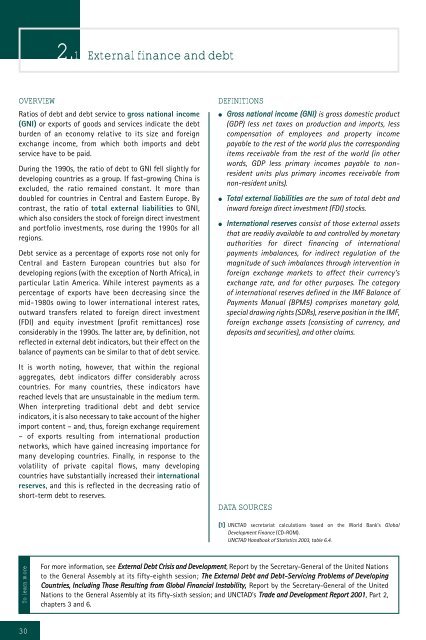Development and Globalization: - Unctad
Development and Globalization: - Unctad
Development and Globalization: - Unctad
Create successful ePaper yourself
Turn your PDF publications into a flip-book with our unique Google optimized e-Paper software.
OVERVIEW DEFINITIONS<br />
Ratios of debt <strong>and</strong> debt service to gross national income<br />
(GNI) or exports of goods <strong>and</strong> services indicate the debt<br />
burden of an economy relative to its size <strong>and</strong> foreign<br />
exchange income, from which both imports <strong>and</strong> debt<br />
service have to be paid.<br />
During the 1990s, the ratio of debt to GNI fell slightly for<br />
developing countries as a group. If fast-growing China is<br />
excluded, the ratio remained constant. It more than<br />
doubled for countries in Central <strong>and</strong> Eastern Europe. By<br />
contrast, the ratio of total external liabilities to GNI,<br />
which also considers the stock of foreign direct investment<br />
<strong>and</strong> portfolio investments, rose during the 1990s for all<br />
regions.<br />
Debt service as a percentage of exports rose not only for<br />
Central <strong>and</strong> Eastern European countries but also for<br />
developing regions (with the exception of North Africa), in<br />
particular Latin America. While interest payments as a<br />
percentage of exports have been decreasing since the<br />
mid-1980s owing to lower international interest rates,<br />
outward transfers related to foreign direct investment<br />
(FDI) <strong>and</strong> equity investment (profit remittances) rose<br />
considerably in the 1990s. The latter are, by definition, not<br />
reflected in external debt indicators, but their effect on the<br />
balance of payments can be similar to that of debt service.<br />
It is worth noting, however, that within the regional<br />
aggregates, debt indicators differ considerably across<br />
countries. For many countries, these indicators have<br />
reached levels that are unsustainable in the medium term.<br />
When interpreting traditional debt <strong>and</strong> debt service<br />
indicators, it is also necessary to take account of the higher<br />
import content – <strong>and</strong>, thus, foreign exchange requirement<br />
– of exports resulting from international production<br />
networks, which have gained increasing importance for<br />
many developing countries. Finally, in response to the<br />
volatility of private capital flows, many developing<br />
countries have substantially increased their international<br />
reserves, <strong>and</strong> this is reflected in the decreasing ratio of<br />
short-term debt to reserves.<br />
To learn more<br />
30<br />
2.1 External finance <strong>and</strong> debt<br />
● Gross national income (GNI) is gross domestic product<br />
(GDP) less net taxes on production <strong>and</strong> imports, less<br />
compensation of employees <strong>and</strong> property income<br />
payable to the rest of the world plus the corresponding<br />
items receivable from the rest of the world (in other<br />
words, GDP less primary incomes payable to nonresident<br />
units plus primary incomes receivable from<br />
non-resident units).<br />
● Total external liabilities are the sum of total debt <strong>and</strong><br />
inward foreign direct investment (FDI) stocks.<br />
● International reserves consist of those external assets<br />
that are readily available to <strong>and</strong> controlled by monetary<br />
authorities for direct financing of international<br />
payments imbalances, for indirect regulation of the<br />
magnitude of such imbalances through intervention in<br />
foreign exchange markets to affect their currency’s<br />
exchange rate, <strong>and</strong> for other purposes. The category<br />
of international reserves defined in the IMF Balance of<br />
Payments Manual (BPM5) comprises monetary gold,<br />
special drawing rights (SDRs), reserve position in the IMF,<br />
foreign exchange assets (consisting of currency, <strong>and</strong><br />
deposits <strong>and</strong> securities), <strong>and</strong> other claims.<br />
DATA SOURCES<br />
[1] UNCTAD secretariat calculations based on the World Bank’s Global<br />
<strong>Development</strong> Finance (CD-ROM).<br />
UNCTAD H<strong>and</strong>book of Statistics 2003, table 6.4.<br />
For more information, see External Debt Crisis <strong>and</strong> <strong>Development</strong>, Report by the Secretary-General of the United Nations<br />
to the General Assembly at its fifty-eighth session; The External Debt <strong>and</strong> Debt-Servicing Problems of Developing<br />
Countries, Including Those Resulting from Global Financial Instability, Report by the Secretary-General of the United<br />
Nations to the General Assembly at its fifty-sixth session; <strong>and</strong> UNCTAD’s Trade <strong>and</strong> <strong>Development</strong> Report 2001, Part 2,<br />
chapters 3 <strong>and</strong> 6.

















